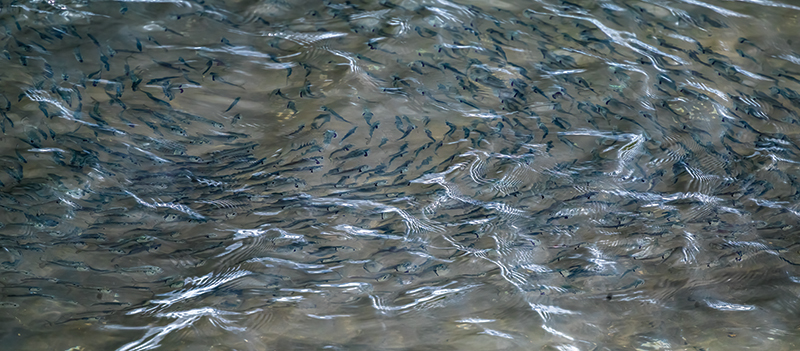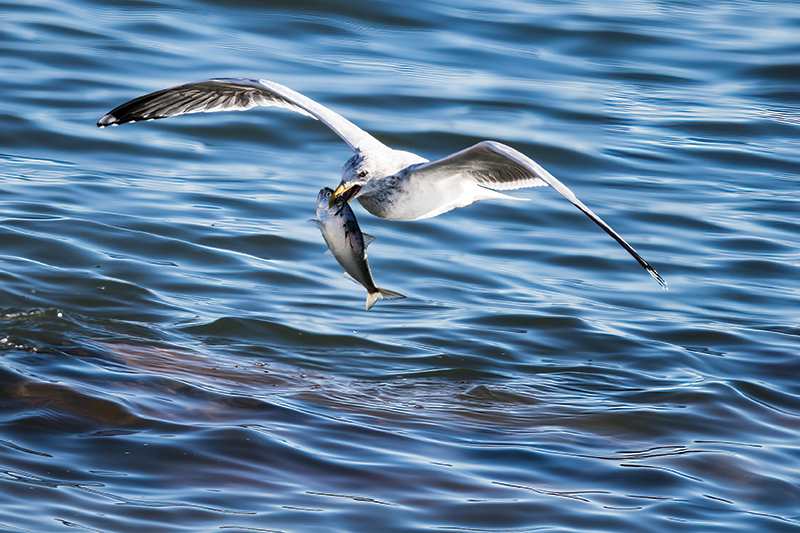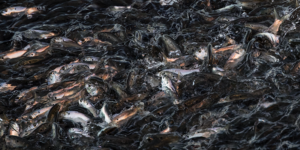
Subadult Menhaden Filter Feeding.
The sun has yet to rise. Dawn light, thin as windowpane glazed with ice. The Autumnal Equinox is well behind. Ten meters above the water a herring gull glides and casts a dark shadow that cannot be a shadow, cannot be directly below him nor as cleanly defined in the absent brightness of not-yet-day. The shadow paces the herring gull, then sporting, now leading. Running, not with. Racing, not towards. But away!
What can it be…
Six weeks the herring gulls did not take notice. They advanced no interpretation. Why should they? A herring gull lives a long life, thirty years and more if all goes right. And in that one-third century? A living shadow such as this? Un-encountered.
In the seventh week, herring gulls had their epiphany: The Shadow, is an Arrow, of Fishes!
“Herring” gull (Larus argentatus) is a common name that always puzzled me. Herring gulls take tautog and sand dab fry, silversides, quahogs sometimes of remarkable heft and diameter, oysters, blue mussels, horse mussels, the occasional fragmentary snapper blue despoiled by ravening striped bass, glass shrimp, green crabs, spider crabs, hermit and blue crabs, and from time to time sea weed, and insects in midair—which is to say, anything small enough to grasp in a herring gull beak and not too large to slip down a herring gull throat. Except, herring! And yet the name. That Shadow Arrow of Fishes was our joint revelation.
The fish that loose the arrow are a species of herring we call menhaden, this after an ancient name given by the First Nations. No doubt mispronounced. Certainly misunderstood; we thought the sea was inexhaustible. Menhaden to this day are reduced to fertilizer, fish oil, fish meal for farm-raised salmon and chicken feed, for lobster bait and dog food. In enormous quantities. In August of 2020, after a quarter century of pressure culminating with 150,000 private citizens coming forward to urge more stringent menhaden conservation, the Atlantic States Marine Fisheries Commission agreed for the first time to consider the needs of predatory fish in setting limits on the catch. The effect seemed to be immediate. By October 2020 huge numbers of adult menhaden filled Long Island Sound, literally millions visiting the inshore waters of Connecticut’s Stewart B. McKinney National Wildlife Refuge. Between Menunkatesuck Island at the mouth of the Menunkatesuck River in Westbrook and the shoreline, for miles in all directions the sea was thick with menhaden, their transparent yellow fins flagging the surface like the untrimmed threads of an enormous carpet. What had been for gulls the occasional accidental find washed up on the beach became over time an occupation: Herring gulls learning to be “herring” gulls.

Sucess!
It began with the gulls investigating that arrow they had at first ignored. Flights thirty meters high became two meters, then one, then even less. Dipping their heads, the gulls tried to snag menhaden from the sea on the fly. Of the many, many tries I witnessed, very few in this method were successful. That arrow meant menhaden were already in a panic. “Bird in Flight” was their warning flag and the fish had no time or intention to sort it any further, fleeing geese and buffleheads as much as osprey and gulls. Ultimately it did not much help them.
Menhaden feed on plankton. Extending their mouths into a scoop wider than their bodies they filter out single-celled life that is their sustenance. The fish work together, small knots of ten, fifteen, maybe twenty swimming in tight circles and thus treading over each other. These rotating circles of knots do not stay in one place. They drift, but very slowly, and plankton in the immediate vicinity should have been exhausted in a single rotation. Clearly not. The motion of the fish probably creates a vortex, stirring the plankton-rich water, drawing phytoplankton and zooplankton up and around and down again in a liquid version of a smoke ring. Or, like stirring a cup of coffee with a spoon. The circles gave the gulls their ultimate target. They swooped in at a shallow angle and landed in the midst. It worked but not well. Ultimately, it was the black-backed gulls who showed the herring gulls how it was done, plunge diving, sometimes from the air, sometimes when already on the water by leaping up and arcing in, beak first. Herring gulls quickly realized the value though not with instant finesse. A black-backed gull weighs one and a half times what a herring gull weighs. For a herring gull, the effort required to go deep enough to capture menhaden is therefore greater. Over the next two years, the splash herring gulls made grew in height and breadth as more and more effort was donated to the plunge. In a rare privilege, I witnessed adult wild animals recovering their eponymous birthright.
Then in the fall of 2022 the great carpeting of menhaden vanished. Patches of adult fish showed up for the most part not until late November and into early December and with only a scattering taken by the gulls. At the same time, Long Island Sound Keeper Bill Lucey reported that alewives, another all-important herring species, had decreased by at least 400,000 individuals, this due to the tremendous accidental take or “bycatch” that occurs in the Atlantic herring and mackerel fisheries. It is possible some of the absent menhaden may have fallen victim to Vibrio anguillarum, a bacterium known to have caused menhaden die-off in other waters. There is some evidence in Connecticut. Towards the end of 2021, there were dead fish on the beach which were unmarked and therefore not victims of predation or boat collisions. By early winter they weathered down to small collections of menhaden skulls entangled in the wrack line. The skulls were few, and a possible menhaden bycatch is worth consideration. However, there is also the quota to consider. In early August, the Atlantic States Marine Fisheries Commission increased the allowable take for menhaden by twenty percent to 223,000 metric tons. If constituted in full-grown adults, this is equivalent of at least 497,000,000 individual menhaden. Since many of these fish will not be full-grown the actual haul will be larger.

Peanut bunker crowded against the shore.
The downside is not the entire story. Despite the apparent disruption to the fall adult menhaden run, juveniles (known as peanut bunker) were super-abundant. What this states unequivocally is the possibility of recovery—and rapid recovery at that.
We encourage ourselves to Think Big. But the Small is everything. The ancient grain that filled the granaries upon which Civilization itself was built literally depended on the bacteria of the Nitrogen Cycle. It is the lynch pin even now. No nitrogen fixation, no skyscrapers, no journey to the stars. Sterilize our gut bacteria, we die. Mitochondria which are the literal fuel cells of our being are the symbiotic gift of a virus. Syncytin—essential to the cell fusion from which the placental wall derives—the same. That which is Us thus depends on the Small, and we therefore speak of life in terms of its foundation, bottom up. But this is a terrestrial perspective.
And the ocean is a top-down affair.
Life on earth floats in the vanishingly small percentage of the water column penetrated by the light of the sun. Menhaden and the other fish we call forage fish “forage” the phytoplankton, zooplankton, and algae found at the top. What feeds the deeps filters down. And down. Krill, sardines, mackerel, and herring derived from this high light-born source are to the sea what wheat, rice, millet, buckwheat, and corn are to the land. Without the minnow-sized fishes? No big fish. No sea birds. Without krill? No blue whales. No penguins. Nor the leopard seals that feed on penguins. It is the ocean from which we came. If we bleed, lost volume can be restored by water and salt. We walk on land because our kidneys make it possible to take the ocean with us, to recycle it, to keep it clean. Our hearts simulate the action of wave and tide. The very oxygen that fills our lungs (that once were gills) is made, most of it, in that narrow sunlit slice of ocean.
Nature is infinitely interconnected, a fact that we cannot escape. Without life in the sea in a plentiful and healthy state, it is not the sea alone that is at risk.

The sea a carpet of menhaden.

